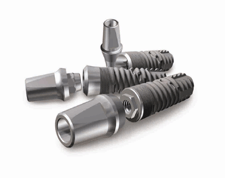المقالات
Single Tooth

Whenever you lose a tooth, the biting forces change on the teeth next to the space, causing them to shift. Opposing teeth may even begin to extrude out of the socket, which means they too could eventually be lost.
Also, as your bite changes, it gets more difficult to chew your food, and you may suffer damage to your jaw joint. It's also much harder to clean teeth that have shifted; harmful plaque and tartar collect in the new hardto-reach places created by the shifting, causing tooth decay and periodontal disease.
As you can see, it's critical that we replace a lost tooth. An excellent option for replacing a missing tooth is an artificial tooth secured by a dental implant. Implants are titanium cylinders that are surgically placed in your jaw to serve as artificial tooth roots. Attaching a replacement tooth to an implant allows us to avoid placing a bridge. Bridges require that we prepare the adjacent natural teeth, and that weakens them substantially.
An implant and crown is practically indistinguishable from your natural teeth, and it fits so securely that you won't even notice it when you chew and speak. When we place an implant, it's not necessary for us to alter the structure of the adjacent teeth, so their strength and integrity is maintained. Also, an implant replaces the roots of a missing tooth, which helps to fend off the bone loss that occurs when a tooth is missing. In essence, an implant is the next best thing to your natural tooth.
Start-to-finish, the procedure may require several months to complete, because it can take about four to six months for the implant to fuse to your bone tissue through a process called osseointegration. An implant won't work for you if you aren't in good general health. Your gums and jaw bone must be healthy enough to support the implant, and you must be meticulous about your daily home care routine. You'll also need to visit us up to four times a year for cleanings.
We won't recommend an implant if you suffer from a chronic illness such as diabetes, as this can interfere with healing. And if you're a smoker, you may not be a good candidate for an implant; smokers are at greater risk for gum disease, and gum disease weakens the bone and soft tissue needed to support the implant.
If you're interested in replacing a missing tooth with an implant, we will perform a thorough evaluation to determine whether your health and lifestyle make you a good candidate for this kind of restoration.
Restoring your mouth with a dental implant is accomplished in two phases. The first phase of the procedure is the surgical placement of the implant. It's under the gums for several months while the bone attaches to it. After healing, the second phase begins. The implant is re-exposed and your new crown is made.
For the surgical placement of the implant, your mouth will be thoroughly numbed. An incision is made in your gums and a channel is made in the bone to receive the implant. After the implant is snugly in place, the gums are closed over the implant with a stitch or two. Over the course of the next few months, the implant becomes securely attached to the bone.
The second phase starts with surgical re-exposure of the implant. Another incision is made in your gums and a small extension is placed to bring it above the gumline.
We then start a series of appointments to make your new crown. Though some of the steps might be different in your case, they usually include making impressions of your mouth. From these impressions, we make precise working models of your mouth, which are carefully mounted for proper alignment. Your crown is fabricated on these models. The last step is the placement of your new crown.
The success of your implant depends on your care of the implant at home, and our support through regular checkups and cleanings here in our office.
